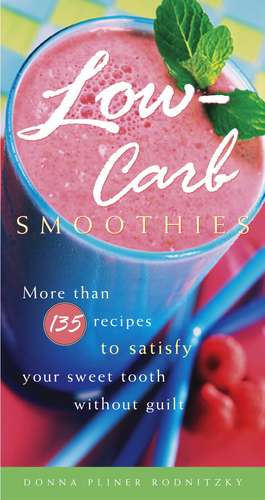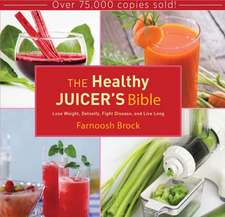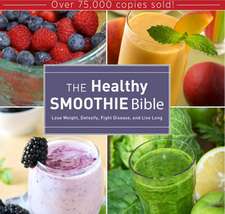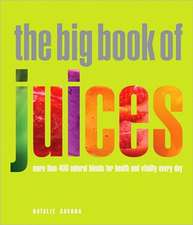Low-Carb Smoothies: More Than 135 Recipes to Satisfy Your Sweet Tooth Without Guilt
Autor Donna Pliner Rodnitzkyen Limba Engleză Paperback – 31 ian 2005
If you’re a committed carbohydrate counter or a calorie-conscious eater, you can reclaim the pleasure of sipping a yummy, nutritious smoothie. Donna Pliner Rodnitzky, a proven master at whipping up palate-pleasing glassfuls, presents a host of great-tasting, sin-free delights.
In Low-Carb Smoothies, you’ll learn how to transform a carb-and calorie-laden smoothie into a guiltless treat by replacing forbidden ingredients with intensely flavored sugar-free syrups, low-glycemic fruits, and protein powders. Get tips on how to find the best fruit and the basic equipment you’ll need to create low-carb smoothie perfection. With both low-carb and ultra-low-carb options, you’ll find recipes to suit every phase of your diet, whether you’re on the most stringent plan or in a less-restrictive maintenance phase. All the recipes minimize the carb count and maximize taste.
Discover too a host of ideas for low-carb garnishes, from strawberry fans to carb-friendly peanut-butter cookies, to make your smoothies not only taste great but look great. A smoothie is the perfect treat to serve your guests at the end of a meal or as a midday refresher—they’ll never know it’s diet-friendly.
Choose from a host of delectable recipes, including:
•Huckle–berry Thin
•Blueberry Chill
•Coconut CarbBuster
•Raspberry Tornado
•South Peach to Diet For
•Raspberry Chocolate Espresso
•Chocolate Almond Bar Smoothie
•Peanut Butter Cup
•Happily Ever Apple
•And more . . .
Preț: 85.17 lei
Nou
Puncte Express: 128
Preț estimativ în valută:
16.30€ • 17.02$ • 13.49£
16.30€ • 17.02$ • 13.49£
Carte disponibilă
Livrare economică 15-29 martie
Preluare comenzi: 021 569.72.76
Specificații
ISBN-13: 9781400082308
ISBN-10: 1400082307
Pagini: 218
Dimensiuni: 106 x 220 x 12 mm
Greutate: 0.2 kg
Editura: Three Rivers Press (CA)
ISBN-10: 1400082307
Pagini: 218
Dimensiuni: 106 x 220 x 12 mm
Greutate: 0.2 kg
Editura: Three Rivers Press (CA)
Notă biografică
Donna Pliner Rodnitzky started her culinary career as a caterer prior to becoming a cookbook author. She is the author of twelve cookbooks, including Ultimate Smoothies, Slim Smoothies, Summer Smoothies, Tipsy Smoothies, Sinful Smoothies, and The Ultimate Low-Carb Diet Cookbook. She lives in Iowa City, Iowa.
Extras
1: The Skinny on Low-Carb Diets: What's It All About?
If you wish to grow thinner, diminish your dinner. —H. S. Leigh
Understanding the metabolic and nutritional principles behind the low-carbohydrate diet is not rocket science, but without an adequate discussion outlined in simple terms it can seem that way. There are only a few simple definitions that you need to familiarize yourself with in order to clearly understand the scientific theory behind the diet and how it allows you to lose weight in an easy and healthful way. So, before delving into the explanation, let's define those terms that will set you on the pathway to becoming a first-class carbomeister.
Calorie: Officially a measure of heat, a calorie, in dietary terms, is a measure of the amount of energy the body can derive from a particular food. The more calories provided by a foodstuff, the longer it will take the body to "burn up" that nutrient.
Carbohydrate: Carbohydrates are one of three major nutrient groups that provide energy for the body, the other two being protein and fat. All carbohydrates are composed of single sugars or strings of sugar bound together. Single sugars, such as table sugar (sucrose), fruit sugar (fructose), and dairy sugar (lactose), are referred to as simple carbohydrates. Plants bind excessive sugars together, resulting in complex carbohydrates, often referred to as starches. Most complex carbohydrates, such as potato starch or wheat flour, are edible and digestible, but some, such as cellulose (from celery), cannot be digested.
Glucose: Glucose (also known as dextrose) is a simple sugar found in fruits and honey. It is also the form of sugar that circulates in the human bloodstream. The blood level of glucose is the major stimulus for insulin secretion from the pancreas.
Glycogen: Glycogen is the form in which the body stores excess glucose in the liver and muscles. It is essentially composed of a number of glucose molecules strung together. Glycogen is an energy storehouse for the body, and when needed, it can be broken down into glucose and released from its storage sites.
Glucagon: Glucagon is one of two major hormones produced by the pancreas (the other is insulin). When the blood sugar level is low, glucagon is released and acts to stimulate the liver to break down its stored glycogen into glucose and release it into the bloodstream. This hormone also promotes the breakdown of protein and fat to produce energy when blood glucose is not at an adequate level for the body's needs.
Glycemic Index: The glycemic index of a carbohydrate-containing food is a measure of the degree it raises your blood sugar after it is eaten. For example, white bread raises blood sugar higher and faster than apples, so its glycemic index is high, while apples get a low glycemic index rating.
Insulin: Insulin is one of two major hormones produced by the pancreas (the other is glucagon). It is released by the pancreas when the blood glucose rises and then helps transfer glucose into cells where it can be used as a source of energy. In fatty tissue, insulin promotes the conversion of excess glucose to fat, and in the liver it causes excess glucose to be stored as glycogen. In muscle, it promotes the entry of amino acids, the building blocks of protein. Diabetes is due to inadequate production of insulin, reduced sensitivity to its effect, or both. When insulin secretion is excessive, this hormone can elevate cholesterol levels and inhibit the breakdown of previously stored fat.
Ketones: Ketones are chemicals that result from the breakdown of fat that occurs when the body does not have enough glucose for energy production and the liver's store of glycogen has been used up. Although there are always some ketones circulating in the bloodstream, fasting or a very low-carbohydrate diet increases the amount of these substances, creating a condition referred to as ketosis.
With these definitions in mind, how does the low-carbohydrate diet work? In the simplest terms, the body's response to a carbohydrate meal is to secrete insulin, while at the same time suppressing release of the other pancreatic hormone, glucagon. As we age, excessive insulin secretion can occur in response to even ordinary amounts of carbohydrates in the diet because of insulin resistance, a condition in which our cells respond subnormally to the hormone, requiring the pancreas to secrete more of it just to achieve a normal effect. One of the basic underlying principals of the low-carbohydrate diet is that insulin (especially excessive insulin) has potentially negative health effects, while the opposite is true for glucagon. After a high-carbohydrate meal, insulin tries to store the excess glucose derived from the meal as glycogen in the liver and muscles. Because this storage capacity is limited and easily saturated, insulin next turns to fat as a storage vehicle for the remaining glucose. Not only does excess insulin promote the deposition of fat in this way, it may also have other negative health effects, such as elevation of blood cholesterol and retention of fluid and salt.
Now that you understand the metabolic and nutritional principles behind the low-carbohydrate diet, you are ready to become a convert to this exciting way of dieting, or, if you're already converted, to exclaim a few hallelujahs. The common thread running through all low-carb diets is the requirement to restrict the daily consumption of all foods that are high in carbohydrates. It sounds simple, but this may be a challenging feat for many of us to accomplish, and giving up traditionally high-carb foods that have always been a source of enjoyment and satisfaction can be a major stumbling block. Enter Low-Carb Smoothies. Now the promise of being able to enjoy some of the same treats that you savored in the pre-carb era can help you make the leap to a true low-carb lifestyle.
2: Fruit for Thought: Low-Carb Smoothie Ingredients
Time flies like an arrow. Fruit flies like a banana. —Groucho Marx
Fresh fruit is an important component of most smoothies. While many of these delectable bundles of vitamins have a high carbohydrate count, a wide variety of more carb-friendly orchard bounty remains available for use on your mission to create the perfect low-carb smoothie. The objective of this chapter is to acquaint you with these carb-friendly fruits and to guide you in choosing, storing, and preparing them. To begin with, it is important to realize that choosing fruit that is smoothie-ready can be very deceptive, especially if your choice is based on appearance alone. At first glance, a peach may look ripe simply because of its rich color. There are, however, a number of other less obvious but equally important attributes to consider. You should attempt to determine whether the fruit has a fresh aroma, how heavy or dense it is, and whether it is firm yet yields slightly to gentle pressure. These characteristics are often more important than the fruit's color. The good news is that once you become a fruit connoisseur, you will find that it's actually quite easy to determine whether fruit is ripe.
I am certain that as you become more familiar with the wide array of fruit available, you will delight in the excitement of including it in this new generation of delicious smoothies. As you navigate the aisles of your favorite farmer's market or produce department, I hope you find the following information useful in your quest for the best nature has to offer.
APPLE
Apples are believed to have originated in Central Asia and the Caucasus. They have been cultivated since prehistoric times. They were brought to the United States at the beginning of the seventeenth century and later to Africa and Australia. Today, more than a hundred varieties of apples are commercially grown in the United States.
Apples, whether red, green, or yellow, all have a firm, crisp flesh. They are a rich source of fiber. Some apples have a sweet flavor with a hint of tartness, while others are less sweet and more tart. Most apples are delicious when made into a smoothie, but your flavor preference will determine the best variety for you. Apples are available year-round, but are at their peak in October and November.
Selection
When choosing an apple, look for one that is firm and crisp with a smooth, tight skin. Most important, the apple should have a sweet-smelling aroma. Avoid any apple that has a bruised or blemished skin. Buy the organic variety whenever possible. Most nonorganic apples are heavily sprayed with pesticides and later waxed to preserve them and keep them looking fresh. This can affect the taste, not to mention your health. Should you find a worm in an organic apple, simply remove the unwelcome visitor when you cut the apple, thereby removing any health or aesthetic concerns. Wash all apples in cool water and dry them well before cutting. Uncut apples can be stored in the crisper bin of the refrigerator for up to six weeks if they are kept separate from other fruits and vegetables.
APRICOT
The apricot is a round or oblong fruit measuring about two inches in diameter with skin and flesh that are golden orange in color. It is a very sweet and juicy fruit with a single, smooth stone. The apricot is native to North China and was known to be a food source as early as 2200 B.C. Apricots are available from May through July.
Selection
When choosing apricots, look for those that are well colored, plump, and fairly firm but yield slightly when gently pressed. An apricot that is soft to the touch and juicy is fully ripe and should be eaten or used in a smoothie right away. If an apricot is hard, it can be placed in a brown paper bag and allowed to ripen at room temperature for a day or two. Avoid apricots that are green in color because they will not ripen or be good for consumption. Refrigerate ripe apricots in the crisper bin of the refrigerator for up to a week. Wash them in cool water just before using them.
BANANA
The banana has been around for so long that according to Hindu legend, it was actually the forbidden fruit of the Garden of Eden. It is also believed that the banana was widely cultivated throughout Asia and Oceania before recorded history and that the Spanish colonists introduced banana shoots to the New World in 1516.
Bananas have a high glycemic level and should be avoided when following a low-carb diet. For those who have achieved their weight-loss goal, adding a banana to one's diet is a healthy alternative. Bananas are available year-round.
Selection
Bananas are picked when they are green and sweeten as they ripen. When choosing a banana, look for one that is completely yellow. The riper a banana, or the more yellow its skin, the sweeter it is. Bananas that are yellow but have green tips and green necks or that are all yellow except for light green necks are also ready to eat. Green bananas will ripen at room temperature in two or three days. Alternatively, they can be placed in a brown paper bag to accelerate the ripening process. If a tomato or apple is added to the bag, the bananas will ripen even faster because fruit cells produce a colorless gas called ethylene, which stimulates ripening in many fruits and some vegetables. Ripe bananas can be stored at room temperature or in the refrigerator for a couple of days.
BLACKBERRY
The blackberry is a small black, blue, or dark red berry that grows on thorny bushes (brambles). These berries are oblong in shape and grow up to one inch in length. The United States is the world's dominant producer of blackberries. Blackberries are at their peak in flavor and availability from June through September, but may still be found in some supermarkets from November on into April.
Selection
When choosing blackberries, look for ones that are plump and solid with full color and a bright, fresh appearance. Place them in a shallow container to prevent the berries on top from crushing those on the bottom. Cover the container and store it in the crisper bin of the refrigerator for one to two days. Wash blackberries in cool water just before you are ready to use them.
BLUEBERRY
Native to North America, the blueberry has the distinction of being the second most popular berry in the United States. It has been around for thousands of years, but was not cultivated until the turn of the twentieth century. Today, 95 percent of the world's commercial crop of blueberries is grown in the United States. Blueberries are at their peak in flavor from mid-April to late September. They are available in the southern states first and gradually move north as the season progresses.
Selection
When choosing blueberries, look for those that are plump and firm with a dark blue color and a silvery bloom. The bloom on blueberries is the dusty powder that protects them from the sun; it does not rinse off. Avoid any berries that appear to be dull because this may indicate that the fruit is old. Blueberries should be prepared in the same way as blackberries, washed just prior to use, but they can be stored unwashed for a longer time in the crisper bin of the refrigerator, from three to five days.
KIWIFRUIT
The kiwifruit, about the size of a plum, grows on a vine. It has a brown fuzzy skin and a luscious sweet-and-sour emerald green pulp that surrounds a cluster of black seeds. Kiwifruit originated in the 1600s in the Yangtze River valley in China, where it was called Yangtao. In 1906, Yangtao seeds were sent to New Zealand, where the fruit was renamed the Chinese gooseberry. In 1962, the Chinese gooseberry was shipped to the United States, where it was again renamed the kiwifruit in honor of New Zealand's famous national bird. Kiwifruit are at their peak from June to October.
Selection
When choosing a kiwifruit, look for one that is light brown, has a sweet aroma, and is firm yet will give slightly when pressed. Kiwifruit will ripen at room temperature in three to five days. Kiwifruit can also be placed in a brown paper bag along with an apple or banana to speed the ripening process. Store ripe kiwifruit in the crisper bin of the refrigerator for up to three weeks.
ORANGE
Fresh oranges are widely grown in Florida, California, and Arizona and are available all year long. The two major varieties are the Valencia and navel. Two other varieties grown in the Western states are the Cara Cara and Moro (similar to the blood orange). Moros are available from December through May and Cara Cara from late December through March.
Selection
When selecting an orange, look for one that is heavy for its size and firm. Avoid oranges with a bruised skin, indicating possible fermentation, as well as those with a loose skin, suggesting they may be dry inside. Although oranges can be stored at room temperature for a few days, their flavor is best when they are kept refrigerated for up to two weeks.
If you wish to grow thinner, diminish your dinner. —H. S. Leigh
Understanding the metabolic and nutritional principles behind the low-carbohydrate diet is not rocket science, but without an adequate discussion outlined in simple terms it can seem that way. There are only a few simple definitions that you need to familiarize yourself with in order to clearly understand the scientific theory behind the diet and how it allows you to lose weight in an easy and healthful way. So, before delving into the explanation, let's define those terms that will set you on the pathway to becoming a first-class carbomeister.
Calorie: Officially a measure of heat, a calorie, in dietary terms, is a measure of the amount of energy the body can derive from a particular food. The more calories provided by a foodstuff, the longer it will take the body to "burn up" that nutrient.
Carbohydrate: Carbohydrates are one of three major nutrient groups that provide energy for the body, the other two being protein and fat. All carbohydrates are composed of single sugars or strings of sugar bound together. Single sugars, such as table sugar (sucrose), fruit sugar (fructose), and dairy sugar (lactose), are referred to as simple carbohydrates. Plants bind excessive sugars together, resulting in complex carbohydrates, often referred to as starches. Most complex carbohydrates, such as potato starch or wheat flour, are edible and digestible, but some, such as cellulose (from celery), cannot be digested.
Glucose: Glucose (also known as dextrose) is a simple sugar found in fruits and honey. It is also the form of sugar that circulates in the human bloodstream. The blood level of glucose is the major stimulus for insulin secretion from the pancreas.
Glycogen: Glycogen is the form in which the body stores excess glucose in the liver and muscles. It is essentially composed of a number of glucose molecules strung together. Glycogen is an energy storehouse for the body, and when needed, it can be broken down into glucose and released from its storage sites.
Glucagon: Glucagon is one of two major hormones produced by the pancreas (the other is insulin). When the blood sugar level is low, glucagon is released and acts to stimulate the liver to break down its stored glycogen into glucose and release it into the bloodstream. This hormone also promotes the breakdown of protein and fat to produce energy when blood glucose is not at an adequate level for the body's needs.
Glycemic Index: The glycemic index of a carbohydrate-containing food is a measure of the degree it raises your blood sugar after it is eaten. For example, white bread raises blood sugar higher and faster than apples, so its glycemic index is high, while apples get a low glycemic index rating.
Insulin: Insulin is one of two major hormones produced by the pancreas (the other is glucagon). It is released by the pancreas when the blood glucose rises and then helps transfer glucose into cells where it can be used as a source of energy. In fatty tissue, insulin promotes the conversion of excess glucose to fat, and in the liver it causes excess glucose to be stored as glycogen. In muscle, it promotes the entry of amino acids, the building blocks of protein. Diabetes is due to inadequate production of insulin, reduced sensitivity to its effect, or both. When insulin secretion is excessive, this hormone can elevate cholesterol levels and inhibit the breakdown of previously stored fat.
Ketones: Ketones are chemicals that result from the breakdown of fat that occurs when the body does not have enough glucose for energy production and the liver's store of glycogen has been used up. Although there are always some ketones circulating in the bloodstream, fasting or a very low-carbohydrate diet increases the amount of these substances, creating a condition referred to as ketosis.
With these definitions in mind, how does the low-carbohydrate diet work? In the simplest terms, the body's response to a carbohydrate meal is to secrete insulin, while at the same time suppressing release of the other pancreatic hormone, glucagon. As we age, excessive insulin secretion can occur in response to even ordinary amounts of carbohydrates in the diet because of insulin resistance, a condition in which our cells respond subnormally to the hormone, requiring the pancreas to secrete more of it just to achieve a normal effect. One of the basic underlying principals of the low-carbohydrate diet is that insulin (especially excessive insulin) has potentially negative health effects, while the opposite is true for glucagon. After a high-carbohydrate meal, insulin tries to store the excess glucose derived from the meal as glycogen in the liver and muscles. Because this storage capacity is limited and easily saturated, insulin next turns to fat as a storage vehicle for the remaining glucose. Not only does excess insulin promote the deposition of fat in this way, it may also have other negative health effects, such as elevation of blood cholesterol and retention of fluid and salt.
Now that you understand the metabolic and nutritional principles behind the low-carbohydrate diet, you are ready to become a convert to this exciting way of dieting, or, if you're already converted, to exclaim a few hallelujahs. The common thread running through all low-carb diets is the requirement to restrict the daily consumption of all foods that are high in carbohydrates. It sounds simple, but this may be a challenging feat for many of us to accomplish, and giving up traditionally high-carb foods that have always been a source of enjoyment and satisfaction can be a major stumbling block. Enter Low-Carb Smoothies. Now the promise of being able to enjoy some of the same treats that you savored in the pre-carb era can help you make the leap to a true low-carb lifestyle.
2: Fruit for Thought: Low-Carb Smoothie Ingredients
Time flies like an arrow. Fruit flies like a banana. —Groucho Marx
Fresh fruit is an important component of most smoothies. While many of these delectable bundles of vitamins have a high carbohydrate count, a wide variety of more carb-friendly orchard bounty remains available for use on your mission to create the perfect low-carb smoothie. The objective of this chapter is to acquaint you with these carb-friendly fruits and to guide you in choosing, storing, and preparing them. To begin with, it is important to realize that choosing fruit that is smoothie-ready can be very deceptive, especially if your choice is based on appearance alone. At first glance, a peach may look ripe simply because of its rich color. There are, however, a number of other less obvious but equally important attributes to consider. You should attempt to determine whether the fruit has a fresh aroma, how heavy or dense it is, and whether it is firm yet yields slightly to gentle pressure. These characteristics are often more important than the fruit's color. The good news is that once you become a fruit connoisseur, you will find that it's actually quite easy to determine whether fruit is ripe.
I am certain that as you become more familiar with the wide array of fruit available, you will delight in the excitement of including it in this new generation of delicious smoothies. As you navigate the aisles of your favorite farmer's market or produce department, I hope you find the following information useful in your quest for the best nature has to offer.
APPLE
Apples are believed to have originated in Central Asia and the Caucasus. They have been cultivated since prehistoric times. They were brought to the United States at the beginning of the seventeenth century and later to Africa and Australia. Today, more than a hundred varieties of apples are commercially grown in the United States.
Apples, whether red, green, or yellow, all have a firm, crisp flesh. They are a rich source of fiber. Some apples have a sweet flavor with a hint of tartness, while others are less sweet and more tart. Most apples are delicious when made into a smoothie, but your flavor preference will determine the best variety for you. Apples are available year-round, but are at their peak in October and November.
Selection
When choosing an apple, look for one that is firm and crisp with a smooth, tight skin. Most important, the apple should have a sweet-smelling aroma. Avoid any apple that has a bruised or blemished skin. Buy the organic variety whenever possible. Most nonorganic apples are heavily sprayed with pesticides and later waxed to preserve them and keep them looking fresh. This can affect the taste, not to mention your health. Should you find a worm in an organic apple, simply remove the unwelcome visitor when you cut the apple, thereby removing any health or aesthetic concerns. Wash all apples in cool water and dry them well before cutting. Uncut apples can be stored in the crisper bin of the refrigerator for up to six weeks if they are kept separate from other fruits and vegetables.
APRICOT
The apricot is a round or oblong fruit measuring about two inches in diameter with skin and flesh that are golden orange in color. It is a very sweet and juicy fruit with a single, smooth stone. The apricot is native to North China and was known to be a food source as early as 2200 B.C. Apricots are available from May through July.
Selection
When choosing apricots, look for those that are well colored, plump, and fairly firm but yield slightly when gently pressed. An apricot that is soft to the touch and juicy is fully ripe and should be eaten or used in a smoothie right away. If an apricot is hard, it can be placed in a brown paper bag and allowed to ripen at room temperature for a day or two. Avoid apricots that are green in color because they will not ripen or be good for consumption. Refrigerate ripe apricots in the crisper bin of the refrigerator for up to a week. Wash them in cool water just before using them.
BANANA
The banana has been around for so long that according to Hindu legend, it was actually the forbidden fruit of the Garden of Eden. It is also believed that the banana was widely cultivated throughout Asia and Oceania before recorded history and that the Spanish colonists introduced banana shoots to the New World in 1516.
Bananas have a high glycemic level and should be avoided when following a low-carb diet. For those who have achieved their weight-loss goal, adding a banana to one's diet is a healthy alternative. Bananas are available year-round.
Selection
Bananas are picked when they are green and sweeten as they ripen. When choosing a banana, look for one that is completely yellow. The riper a banana, or the more yellow its skin, the sweeter it is. Bananas that are yellow but have green tips and green necks or that are all yellow except for light green necks are also ready to eat. Green bananas will ripen at room temperature in two or three days. Alternatively, they can be placed in a brown paper bag to accelerate the ripening process. If a tomato or apple is added to the bag, the bananas will ripen even faster because fruit cells produce a colorless gas called ethylene, which stimulates ripening in many fruits and some vegetables. Ripe bananas can be stored at room temperature or in the refrigerator for a couple of days.
BLACKBERRY
The blackberry is a small black, blue, or dark red berry that grows on thorny bushes (brambles). These berries are oblong in shape and grow up to one inch in length. The United States is the world's dominant producer of blackberries. Blackberries are at their peak in flavor and availability from June through September, but may still be found in some supermarkets from November on into April.
Selection
When choosing blackberries, look for ones that are plump and solid with full color and a bright, fresh appearance. Place them in a shallow container to prevent the berries on top from crushing those on the bottom. Cover the container and store it in the crisper bin of the refrigerator for one to two days. Wash blackberries in cool water just before you are ready to use them.
BLUEBERRY
Native to North America, the blueberry has the distinction of being the second most popular berry in the United States. It has been around for thousands of years, but was not cultivated until the turn of the twentieth century. Today, 95 percent of the world's commercial crop of blueberries is grown in the United States. Blueberries are at their peak in flavor from mid-April to late September. They are available in the southern states first and gradually move north as the season progresses.
Selection
When choosing blueberries, look for those that are plump and firm with a dark blue color and a silvery bloom. The bloom on blueberries is the dusty powder that protects them from the sun; it does not rinse off. Avoid any berries that appear to be dull because this may indicate that the fruit is old. Blueberries should be prepared in the same way as blackberries, washed just prior to use, but they can be stored unwashed for a longer time in the crisper bin of the refrigerator, from three to five days.
KIWIFRUIT
The kiwifruit, about the size of a plum, grows on a vine. It has a brown fuzzy skin and a luscious sweet-and-sour emerald green pulp that surrounds a cluster of black seeds. Kiwifruit originated in the 1600s in the Yangtze River valley in China, where it was called Yangtao. In 1906, Yangtao seeds were sent to New Zealand, where the fruit was renamed the Chinese gooseberry. In 1962, the Chinese gooseberry was shipped to the United States, where it was again renamed the kiwifruit in honor of New Zealand's famous national bird. Kiwifruit are at their peak from June to October.
Selection
When choosing a kiwifruit, look for one that is light brown, has a sweet aroma, and is firm yet will give slightly when pressed. Kiwifruit will ripen at room temperature in three to five days. Kiwifruit can also be placed in a brown paper bag along with an apple or banana to speed the ripening process. Store ripe kiwifruit in the crisper bin of the refrigerator for up to three weeks.
ORANGE
Fresh oranges are widely grown in Florida, California, and Arizona and are available all year long. The two major varieties are the Valencia and navel. Two other varieties grown in the Western states are the Cara Cara and Moro (similar to the blood orange). Moros are available from December through May and Cara Cara from late December through March.
Selection
When selecting an orange, look for one that is heavy for its size and firm. Avoid oranges with a bruised skin, indicating possible fermentation, as well as those with a loose skin, suggesting they may be dry inside. Although oranges can be stored at room temperature for a few days, their flavor is best when they are kept refrigerated for up to two weeks.













